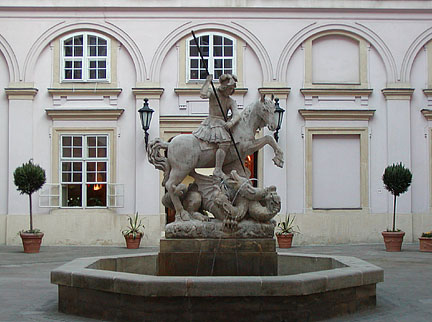|
|
Bratislava is Slovakia’s largest city and is located on the Danube River just south of the northwestern end of the Carpathian Mountains. Bratislava dates from the first century and was the capital of Hungary from 1541 until 1830. At the end of the first world war in 1918 the city was included in the newly formed Republic of Czechoslovakia. In 1993 it became the capital of the independent country of Slovakia. The city was an important merchant city as it sat at the crossroads of the Danube and the Amber trading routes.
|
|
|
|
|
We arrived in Bratislava in mid-July, 2003 and found a thoroughly modern city that has grown up around the old-town center (above). The old city is centered around the Primate’s Palace (rebuilt in the classical baroque style from 1776-1781). This was the palace of the Archbishop. The center court highlights the fountain of St. George slaying the dragon from the first half of the 17th century (below, right).
|
|
|
This palace was where the Pressburg Peace Treaty was signed in 1805 between France and Austria assuring peace and ceding much territory to France (Pressburg was the name of the city until 1919). Found hidden in the walls of the palace were 17th century tapestries from England, supposedly hidden for safekeeping during the Napoleonic wars.
|

|
|
Next to the palace is the original city hall (1421) with its identifying tower (below, left). This picture was taken as the clock was striking 6 PM and we turned to see, listening to the lovely chiming melody. On the tower we noticed the police sharpshooters. The Israeli President was in town and security all around this square was in full force.Just down the street from the city hall is the Franciscan Church (1291), the oldest church in Bratislava. The inside was being renovated while we were there. Along side the church is the chapel added in 1297 (right). The gothic style of the chapel is quite elegant in its simplicity.
Across the street from the church is the Mirbach Palace (1770), now a gallery. The front door to the Palace was a good example of the Rococo style, with the signature shell motif over the beautifully carved doors (below, left).At right, above, is the Michael’s tower, the only tower remaining from the original city fortifications. It is named Michael’s tower from the church of St. Michael which once sat next to the tower. Today it leads the visitor to the center of town, along Michalska (Michael’s Street) as shown above. Although most of the old town is now pedestrianized, Michalska is one of the major walkways, lined with various shops and sidewalk cafes.
|
|
One of the interesting characters of the city is the smiling fellow shown at left. This is said to be the happiest man in town, even though he is homeless, living in the street. The reason (we were told) was that he has the best view up the skirts of all the passing ladies! Even as popular as he is, he has had a few run-ins with vehicles, so the city put up the Man at Work sign to help protect him. He seems to be a favorite with the kids who come and sit on his shoulders, keeping his hat and coat well polished he’s made of bronze.
|
|
Bratislava Castle sits high on the hill above the city. The castle served as the frontier post of the Roman Empire from the 1st to 5th centuries and some remains have been identified. Since the 9th century, the castle has been rebuilt several times and served as the seat of Hungarian royalty until it finally burnt down in 1811. It was reconstructed between 1952 and 1962 and today serves as the home for several museums. From the castle, you can get magnificent views of the Danube and Bratislava. The photo below shows the old city area of Bratislava, with the Danube at the far right.
Below is a view to the south, across the Danube, toward the newer suburbs of Bratislava. In the middle of the picture is the New Bridge (1972), a controversial project at the time because the motorway it carries leads directly into the old center, along the path of the old moat. Due to the construction, many historical buildings had to be demolished. Now they are finding that the vibrations from the busy motorway are damaging the Cathedral located along side (at left in photo above).
|

